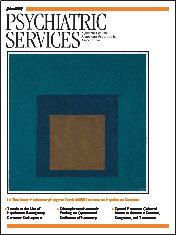Access to Specialty Mental Health Services Among Women in California
Abstract
OBJECTIVE: The Anderson behavioral model was used to investigate racial and ethnic disparities in access to specialty mental health services among women in California as well as factors that might account for such disparities. METHODS: The study was a cross-sectional examination of a probability sample of 3,750 California women. The main indicators of access to services were perceived need, service seeking, and service use. Multivariate models were constructed that accounted for need and enabling and demographic variables. RESULTS: Significant racial and ethnic variations in access to specialty mental health services were observed. African-American, Hispanic, and Asian women were significantly less likely to use specialty mental health services than white women. Multivariate analyses showed that Hispanic and Asian women were less likely than white women to report perceived need, even after frequent mental distress had been taken into account. Among women with perceived need, African-American and Asian women were less likely than white women to seek mental health services after differences in insurance status had been taken into account. Among women who sought services, Hispanic women were less likely than white women to obtain services after adjustment for the effects of poverty. Need and enabling factors did not entirely account for the observed disparities in access to services. CONCLUSIONS: Additional research is needed to identify gender- and culture-specific models for access to mental health services in order to decrease disparities in access. Factors such as perceived need and decisions to seek services are important factors that should be emphasized in future studies.



